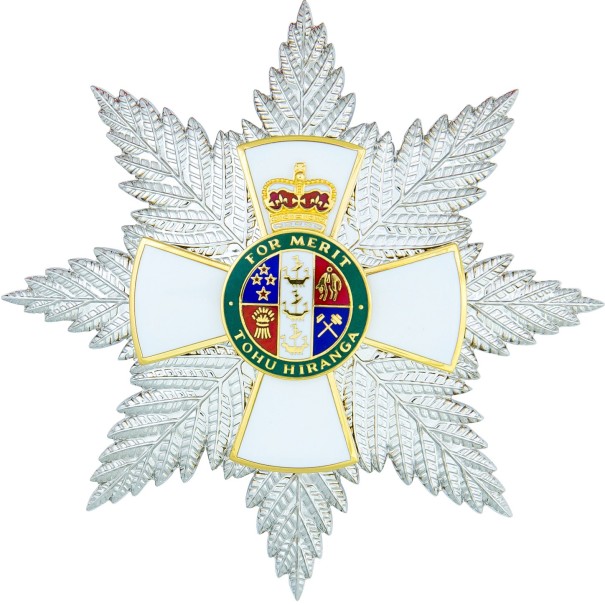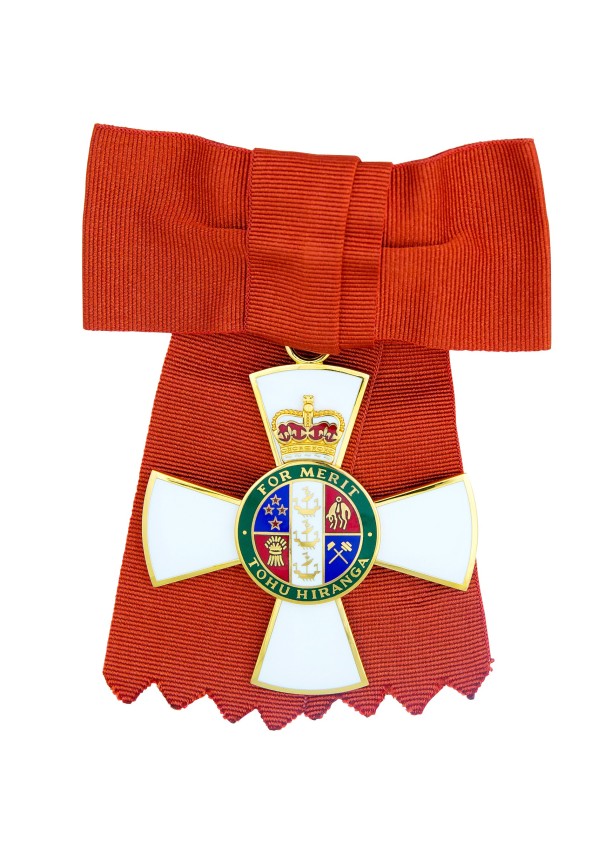Background
The New Zealand Order of Merit was instituted by Royal Warrant dated 30 May 1996. The Order is awarded to those “who in any field of endeavour, have rendered meritorious service to the Crown and the nation or who have become distinguished by their eminence, talents, contributions, or other merits”.
On 10 April 2000 it was announced that Queen Elizabeth II had approved the discontinuation of titles (damehoods and knighthoods) within the Order. The new designations were principal companions and distinguished companions. The first appointments to the re-designated levels were made in The Queen’s Birthday Honours on 5 June 2000.
On 8 March 2009 it was announced that Queen Elizabeth II had given approval for the reinstatement of the titles of Knight and Dame Grand Companion and Knight and Dame Companion. The first appointments to the redesignated levels were made in The Queen’s Birthday Honours on 31 May 2009.
There were 85 New Zealanders who were appointed Principal Companions and Distinguished Companions of the Order between 2000 and 2008. An opportunity was provided for them to be redesignated either a Dame or Knight Grand Companion or Dame or Knight Companion within the Order.
History
The concept of the Order arose out of the recommendations of the Prime Minister’s Honours Advisory Committee in 1995 which recommended that appointments to the various British State Order of Chivalry and other awards be discontinued.
Sovereign
His Majesty The King is Sovereign and the Governor-General is Chancellor of the Order. There is also a Secretary and Registrar (the Clerk of the Executive Council) and a Herald (the New Zealand Herald of Arms) of the Order.
Membership
The Order allows for Ordinary, Additional and Honorary membership. Those citizens of countries of which The Queen is sovereign are eligible for Ordinary membership.
Additional members are appointed on significant royal, national or state occasions.
Those who are citizens of countries of which The King is not sovereign are eligible to be appointed Honorary members.
Levels
There are five levels within the Order:
1996 to 1999 and from 2009 | 2000 to 2008 |
|---|---|
Dames and Knights Grand Companions Dames and Knights Companions Companions Officers Members | Principal Companions Distinguished Companions Companions Officers Members |
Dames Grand and Knights Grand Companion, Dames and Knights Companion, and Principal and Distinguished Companions
Click here to see a list of the current Dames Grand and Knights Grand Companion, Dames and Knights Companion, and Principal Companions and Distinguished Companions of the Order.
Insignia
The insignia of the Order consist of:
Knights and Dames Grand Companion (GNZM) and Principal Companions (PCNZM)

A badge, in the form of a cross in white enamel set in silver-gilt (gold) with, in the centre, a medallion comprising the New Zealand Coat of Arms in coloured enamel, within a circle of green enamel bearing the motto of the Order and surmounted by a Royal Crown. Since the Royal Warrant was revised in 2009, the badge may be worn in three ways: suspended from a wide ribbon or sash over the right-hand shoulder, passing to the left-hand side of the waist, and resting on the left hip; from a neck ribbon; or from a ribbon bow worn on the left shoulder.
A gold breast star, of eight points, each arm bearing in relief a representation of a fern frond, superimposed in the centre of which is a small representation of the badge of the Order. The breast star is worn on the left-hand side.
Knights and Dames Companions (KNZM and DNZM) and Distinguished Companions (DCNZM)
A badge and breast star similar to that prescribed for Principal Companions and Knights and Dames Grand Companions except that the badge is worn from either a neck ribbon or from a bow on the left shoulder (not from a sash). The breast star is in silver, with the badge of the Order in the centre.
Companions (CNZM)

A badge similar to that prescribed for PCNZM/GNZM and DCNZM and KNZM/DNZM. It is worn from either a neck ribbon or from a bow on the left shoulder.
Officers (ONZM)
A smaller representation of the badge, in silver-gilt, with the motto set in green enamel. It is worn from a ribbon on the left lapel of the coat or from a ribbon tied in a bow and worn on the left shoulder.
Members (MNZM)
A badge similar to that prescribed for Officers, except that it is in silver and green enamel. It is worn in the same manner as the Officer’s badge.
Other insignia includes:
Collar of the Order
The Collar (chain) of the Order is composed of links of the central medallion of the badge and gold Koru (in the form of the letter S) with, in the centre (or front) a representation of the New Zealand Coat of Arms from which the badge of the Order hangs. The Collar is only worn by the Sovereign and the Chancellor (Governor-General) of the Order.
Lapel badges and miniatures
Lapel badges for everyday wear, and miniatures for evening wear, and on other appropriate occasions, are available to members of the various levels of the Order.
The insignia of The New Zealand Order of Merit is currently supplied by Thomas Fattorini Ltd., of the United Kingdom, and Eng Leong Medallic Industries Pte Ltd., of Singapore.
Motto
The motto of the Order is FOR MERIT, in English, and TOHU HIRANGA, in Māori. The literal translation of the Māori is “to achieve excellence”.
Symbolism
As the Order is an ‘Order of Chivalry’, a cross [a straight cross paty (or formy) convex] was selected for the badge. The particular shape of the cross chosen is not significant, although it has been found on several Māori tribal flags of the nineteenth century. The motto is set in green enamel which alludes to the highly prized pounamu or New Zealand greenstone (nephrite) which is noted for its beauty and toughness.
The breast star is based on the head or crown of the ponga or silver fern tree (cyathea dealbata) which is common throughout the country. It is regarded as a national emblem of New Zealand. The fern frond, in particular the silver fern frond, is to New Zealand what the oak leaves are to England and the laurel leaves to the world at large, i.e. the symbol of the champion, the winner or the achiever.
The collar provides a blend of both English and Māori cultures and alludes to the ancient origins of both, in particular the concept of chivalry. The koru is found in many forms in Māori art and is a stylised representation of a fern frond. It may symbolise new birth, growth, vitality, strength and achievement. The earliest known English collars were composed of the letter “S” and the design of the koru is based on this letter.
The ribbon and sash of the Order is plain red ochre (kokowai).
Design of The New Zealand Orders
The Māori dimension
Traditional Māori designs, colours, and symbolism have been blended into the design of the insignia of the three New Zealand Orders (the King's Service Order and associated Medal, the Order of New Zealand, and the New Zealand Order of Merit).
Red ochre (kokowai) has been used in the ribbon of each Order. This colour has a spiritual significance for Māori. Red ochre was given official sanction as a national colour with the institution of the Queen's Service Order in 1975. (Other New Zealand national colours are black and white/silver and these may be found in the design of a variety of ribbons for other medals.) Red and gold are traditional colours associated with knighthood, and red is often used in heraldry to allude to toil, hard work and achievement.
The Warrants of Appointment (certificates) issued to those persons appointed to New Zealand's Orders are in English and Te Reo Māori.
The designer of New Zealand's honours insignia
The various insignia of New Zealand's Orders has been designed by Phillip O’Shea, CNZM, CVO, New Zealand Herald of Arms Extraordinary to The King. He also designed the New Zealand Gallantry and Bravery Awards (except for the Victoria Cross for New Zealand) and many other official medals.
